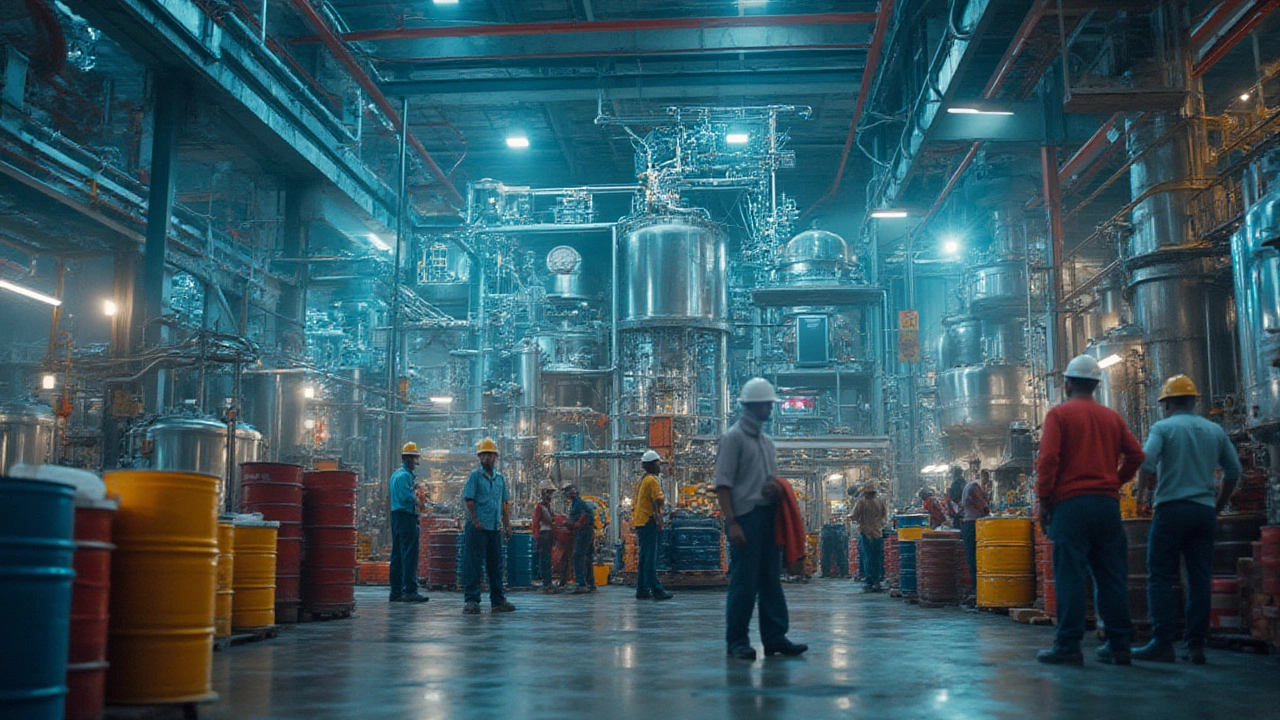Smell the money in the air? From the pungent factories outside Mumbai to the shiny new facilities in Gujarat, India’s chemical sector is exploding—figuratively, of course. Last year, India’s chemical exports crossed a staggering $32 billion, and I’m not just throwing numbers for effect. My kids, Vihaan and Kaia, never stop reminding me how their science experiments at home smell just like the local chemical plants. The difference? Those factories are minting money and reshaping the nation’s economy. There’s a perfect storm of factors—global supply shake-ups, new tech, and a growing home market. So, what’s pushing chemicals to the front of India’s manufacturing march?
Historic Shifts Rewriting the Chemical Playbook
India’s place in the chemical industry wasn’t always this hot. For decades, the sector mostly supplied local needs—dyes, fertilizers, and basic industrial chemicals. The real chessboard changed in the last ten years. China, once the chemical king, started losing its sheen. Wages shot up; tighter environmental rules made many plants slow down or close. Suddenly, the world started looking for a new chemical supplier. India, with its young workforce and lower costs, grabbed the spotlight.
If you’d been watching back in 2014, you’d have seen global giants like BASF and Dow scouting for new ground in Gujarat and Maharashtra. Fast forward to 2024, and over 25% of world’s dyes and dye intermediates come from India. Fertilizer production has nearly doubled since 2010, and specialty chemicals—the stuff that goes into making everything from medicines to paints—now make up 23% of all Indian chemical exports.
Why did this happen? Cheap labor is part of the story, but it’s not that simple. The Indian government began aggressively wooing foreign investors. Investment-friendly states rolled out red carpets with tax breaks, “plug-and-play” industrial parks, and speedy paperwork (well, most of the time—it’s India, after all).
Another twist? The pandemic exposed how vulnerable the global supply chain was, especially when everyone relied on a single country. Companies from Japan, Europe, and even China itself started “China Plus One” strategies. India was ready to fill that ‘one.’
How Local Demand Turbocharged the Sector
It’s not all about exports or foreign money. The real surge started at home. Think about every home you know: from washing powder to paint, fuel additives to plastics, chemicals touch everything. Now multiply that by 1.4 billion people and a fast-growing middle class. Suddenly, everyone wanted better food packaging, slicker cars, more skincare products, and glossier walls. The local demand for finished chemical products—sometimes called “downstream industries”—skyrocketed.
This domestic hunger attracted big investments per a recent ICIS report, which showed that by 2025, more than 60% of revenue in India’s chemical sector could come from within the country. It isn’t just household stuff. Sectors like textiles, construction, agriculture (hello, pesticides and plant nutrients), and pharma all depend on chemical intermediates. Here’s an eyepopper: India is the world’s second-largest consumer of fertilizers, trailing only China. In 2023, Indian farmers used about 61 million tonnes of fertilizers, and 80% of that came from local chemical companies.
My wife, who isn’t too keen on industrial news, recently noticed our local building supply store now stocks six brands of waterproofing chemicals instead of two. Multiply stories like that by every county in India, and you see the tidal wave of opportunity chemical companies are surfing right now.

Exports, Imports, and the Global Tug-of-War
The export boom is impossible to ignore. India now ranks sixth worldwide in chemical production. According to the Indian Ministry of Chemicals and Fertilizers, export values hit $32.2 billion in 2023, up from just $18.5 billion in 2016. The math here is simple: when you can make chemicals at 15–30% lower cost than Europe or the US, buyers come running. Half of India’s chemical exports are now headed to Asian neighbors, Africa, and Latin America, but more and more orders are coming from American and European companies eager for a steady backup to China.
Alongside that, India is importing less. There’s a push for “Atmanirbhar Bharat,” or self-reliant India, and chemicals are at the core of that strategy. In 2021, India produced 80% of its domestic requirement for chemicals—but by 2024, that number crossed 87%. This means not just more exports, but major savings on what would have been costly imports.
Here’s a breakdown of some hot segments in Indian chemical exports (2023):
| Product Segment | Export Value (USD Billion) |
|---|---|
| Dyes & Intermediates | 7.2 |
| Organic Chemicals | 11.1 |
| Agrochemicals | 6.3 |
| Specialty Chemicals | 5.2 |
Want a tip? Companies investing in specialty chemicals are seeing the fattest margins. These chemicals are in constant demand for high-tech manufacturing around the globe, and India’s knack for process engineering makes it a natural contender.
Government Push and Policy Tweaks
If you talk to anyone in the Indian chemical sector—the owner of a mid-sized plant outside Surat, or a techie working on chemical R&D in Hyderabad—they’ll mention one thing: government policy is finally on their side. The Indian government is sinking billions into infrastructure, and chemical clusters are getting their fair share.
Remember the PLI (Production-Linked Incentives) scheme that made headlines for mobile phones and electronics? In 2023, the government extended PLI to the specialty chemical sector. Companies that invest in new capacities get cash incentives based on what they produce. There’s also dedicated funding for green chemistry—think biodegradable packaging and non-toxic additives.
The government is also rolling out “Petroleum, Chemicals, and Petrochemicals Investment Regions” (PCPIRs). These are massive, city-sized zones with built-in logistics links, pre-approved environmental clearances, and tax breaks for new factories. Gujarat, Andhra Pradesh, Odisha, and Tamil Nadu are some of the front-runners in this race.
On the legal front, the government passed updated chemical regulations in 2022 to reassure global buyers about Indian safety and quality standards. This step single-handedly opened doors for more business from the US and EU, where compliance is king.
A not-so-obvious but powerful nudge is also coming from job creation mandates. Every new plant has to hire local talent, and many companies now run their own training centers on-site. This builds a skilled workforce, keeping the sector humming without always looking abroad for experts.

Innovation, Sustainability, and What’s Next
Some folks still have this old-school image of chemical manufacturing—dirty, polluting, and stuck in the past. That’s fading fast. The hunger for innovation is intense. Companies like Tata Chemicals and Aarti Industries are pouring funds into R&D, targeting cleaner processes, zero-waste outputs, and even circular chemistry (where waste from one process is raw material for another).
Here’s a cool fact: over 20 Indian chemical companies filed for global patents in green chemistry in just the last year. Kids learning chemistry now are being taught about “green molecules” and “low-waste synthesis” as the future of the business. Even foreign buyers are asking for sustainability reports on every shipment—it’s not just a bonus; it’s the new entry ticket.
Energy is a huge factor, too. Chemical production can eat up a lot of fuel, but state governments in India are now mandating solar rooftops and waste heat recovery systems. A company in Dahej (Gujarat) cut its power bill by 30% last year by installing solar panels—and bagged a juicy order from France, all because their carbon footprint was lower than a similar Chinese factory.
Tech plays a part as well. Automation, AI, and IoT sensors help cut waste, spot glitches early, and improve safety (always a concern in chemicals—my son’s science teacher calls it “hazard central”). Investors love this. Goldman Sachs reported in late 2024 that Indian chemical stocks shot up 67% in two years, much higher than global averages. No wonder even domestic startups are eyeing chemical tech—there’s real money, and serious impact potential.
Consumers—yes, even rebellious teens like Kaia—are demanding safer, “greener” products. That’s forcing a sea change all the way back to the molecules that fill every bottle, box, and can in Indian households.
Missed the bus? Not yet. With India forecast to double its chemical sector size by 2030, there’s still room to jump in. Just be ready for a wild ride—it smells of hard work, clever solutions, and yes, the odd whiff of triumph. That’s what’s driving India’s chemical sector to boom while most of the world is just trying to stay afloat.
